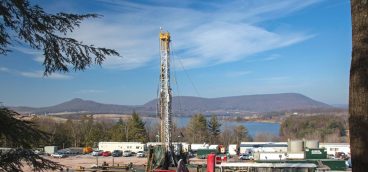
For the past 100 years, the U.S. blossomed in part due to an oil boom with roots in the 19th century, the beginning of the modern oil period.
That was when George Bissell, a school teacher, lawyer, entrepreneur and journalist—a true Renaissance man—conceived the idea that the “rock” oil that bubbled up very near to us—in western Pennsylvania—could replace whale oil, which had become very expensive, to provide safer, modern lighting.
Access to that new energy source and the know-how that developed to produce it drove a century of extraordinary growth. The results provided not only access to the energy source that powered the innovation and extraordinary growth of the U.S. in the 20th century, but it also a provided the U.S. a first-mover advantage in the development of technical know-how.
Precisely the same phenomenon continues to provide Silicon Valley and the businesses located there a competitive edge in the information technology industry.
We are on the verge of a similar inflection point, and Pennsylvania is again poised to be a key player in a new energy era that will benefit individuals, businesses and the domestic economy, and which may transform geopolitical interests.
What is shale? Shale is typically black, ideally rich in organic carbon, and it has extremely low permeability. In other words, we are talking about a rock. “Natural gas from shale” is what we call the gas that is “trapped” in this fine-grained sedimentary rock. In the past we ignored this type of rock. We drilled right through it all over the U.S. to reach oil in deeper deposits.
Locked in very small spaces within the reservoir rock, natural gas is extracted from shale using advanced technologies that allow it to flow to production wells. These recent technological advances—which would be more accurately characterized as the novel use of existing technologies—have opened the door for natural gas from shale rock to become a significant source of energy. In fact, natural gas extracted from dense shale rock formations has become the fastest-growing source of gas in the U.S., and could become a significant new global energy source.
Safety
We work in an incredibly complex business. There are inherent risks in what we do every day. Managing those risks is the most fundamentally important thing we do. Safety and reliability have a direct impact on the bottom line, of course, but are also critical to our reputation. It is our continuing reputation as a safe and reliable operator that allows us to operate around the world.
We are an analytical company and are naturally strong believers in the maxim that you can’t manage what you don’t measure. We employ numerous metrics to comprehensively track our performance on a variety of safety measures related to our people, our assets, the environment and the communities around us. Monitoring in this way provides us with objective measures of our performance, which can be used to help us identify areas for improvement and to help benchmark our initiatives.
Although we are very pleased with our top-tier performance, safety isn’t a relative game. Our aim is zero: zero incidents, zero spills and zero injuries. The recent Lanco incident reminds us that nothing is more important than ensuring incident- and injury-free operations. When it comes to safety, we are striving for perfection. Our goal is simple—everyone goes home safely every day.
Game changer
Hydraulic fracturing is not a new technique and is not used exclusively on gas wells. This process has been used in the U.S. since 1949 on more than 1.2 million wells. In fact, 90 percent of oil and gas wells use hydraulic fracturing technology worldwide. What is relatively new is the combination of hydraulic fracturing and horizontal drilling, which together have unlocked natural gas from shale as well as what we call “tight” oil, which is oil accessed through a similar drilling technology. The discovery and development of natural gas from shale and tight oil have dramatically shifted the global resource picture over the past five years.
We talk about conventional and unconventional resources which, simply put, means gas and oil that’s easier to produce (conventional) as compared to unconventional resources, which are more difficult to produce. Unconventionals, including shale gas and tight oil, take North America from a bit-player role with 7 percent of the world’s recoverable conventional resources, to a leadership position, with 23 percent of the world’s recoverable total conventional and unconventional resources. Unconventional natural gas resources have nearly doubled the size of the world’s estimated recoverable gas resource base. And the world’s remaining recoverable gas resource base could last approximately 225 years at today’s rate of production.
With an estimated 3,600 trillion cubic feet of recoverable natural gas, North America’s remaining resource base would last just over 100 years at current rates of production, thanks in large part to the discovery of unconventional resources. And North America is uniquely positioned to be the global leader in unconventional gas development due to its many advantages over other regions.
It is also important to recognize that the benefits from the U.S. shale boom extend far beyond the hundreds of thousands of workers in the energy industry itself. Thousands of workers in manufacturing and related sectors will benefit from lower energy prices. This is revitalizing our manufacturing base, with many companies announcing plans to invest in America. Indirectly, this will benefit industries that support these sectors, effectively impacting all global energy consumers.
In the U.S., a disproportionate amount of the growth in unconventional gas production will come from the Marcellus, one of the largest resources in the world. This puts Pennsylvania in a unique position to benefit from and contribute to the economic growth of this country, and creates opportunities for us to be at the forefront as this development unfolds. In addition, regions with greater natural gas production tend to benefit from lower prices. These regional differences in price can be significant, and persistent, due to the cost and time required to build infrastructure to liquefy gas for transportation by tanker.
Thus, the increase in U.S. domestic production possible through shale development could help keep the U.S. in a lower natural gas price environment for decades, giving U.S. energy-intensive industries a sustained comparative advantage from lower average energy costs.
Economic impact
Consultants estimate that more than $2.7 trillion in capital expenditures will take place between 2012 and 2025 across the unconventional activity value chain.
The greatest future job growth will occur between now and 2025, during which we forecast that the unconventional activity value chain will stimulate the addition of nearly 1.8 million jobs, bringing the total to 3.9 million workers. On average, direct employment will represent about 20 percent of all jobs resulting from unconventional oil and natural gas activity, with the balance contributed by indirect and induced employment.
Unconventional oil and natural gas activity contributions to federal, state and local tax receipts are projected to grow from an annual contribution of $74 billion in 2012 to $138 billion by 2025. Between 2012 and 2025 the cumulative revenue is expected to total more than $1.6 trillion.
At the household level, reduced direct consumption costs for heating, plus indirect costs for manufactured goods and electricity, plus wage impacts, are expected to boost disposable income by $3,500 per year.
At the federal level, unconventional activities will lead to a vast improvement in the trade deficit. First, the increased domestic energy production allows for export of significant quantities of intermediate and refined energy products. Second, each barrel of increased production cancels out an equivalent imported barrel. Third, reduced energy costs, specifically for electricity and natural gas, improve the global competiveness of energy-intensive manufacturing industries. By 2025, the projected impact of unconventional activities on U.S. net trade is expected to be over $180 billion (equivalent to approximately one-third of the 2012 trade deficit of $540 billion).
Closer to home, the Marcellus Shale is the largest natural gas from shale play in the U.S., and one of the largest in the world. And unlike established regions in the Permian Basin, which have long histories of production, the Marcellus is in its first decade of development.
The Marcellus is already providing significant positive impacts at the local level. Since the end of 2009, employment in Marcellus Shale-related industries in Pennsylvania is up 162 percent and Marcellus-related activities are expected to contribute almost 390,000 jobs by 2035 in Pennsylvania. The Marcellus is also increasing Pennsylvania state and local tax revenues, which are expected to reach nearly $4 billion by 2035.
Community involvement
We believe that strong standards and effective regulation are the keys to earning and keeping the public trust. We also believe that prevention should be the primary focus for industry and regulation. Chevron supports strong state regulations and effective regulatory enforcement to ensure that all companies operate at the same high level. For example, we helped found the Center for Sustainable Shale Development (CSSD), an independent organization formed through collaboration with the environmental community, industry and other stakeholders. This organization has developed 15 performance standards and is implementing a voluntary, third-party certification process to promote effective, sustainable development.
We have created advisory councils in Pennsylvania and West Virginia to provide information and receive feedback from communities. To promote education in science, technology, engineering and math (STEM), we have formed the Chevron Center for STEM Education and Career Development in partnership with Carnegie Science Center. We also work with the Allegheny Conference on efforts to help the local workforce develop skills that will equip them for the well-paying jobs that this growing industry provides.
Q & A
Q: Will the 15 standards released by the CSSD be adopted as either best practice by the Marcellus Shale Coalition or as state regulations in Pennsylvania?
A: In the short term, the goal for the CSSD is to attract more than the current four producers that are part of that coalition, to make it a very proactive and distinguishing, differentiating group to be part of. The intent is to make sure that we are nudging performance standards for all of the industries and all the producers. So, in the long term I think the answer is yes.
Q: So far, the CSSD producers include Chevron, EQT, Consol and Shell. What would be involved in getting more companies involved?
A: You’d have to ask them. The CSSD has just completed its certification process; it has just trained its third-party auditors. I anticipate that we will be applying for certification here in the near future, and I’m sure the other three companies will be doing the same. I think others will watch and wait. I hope what they see is that it differentiates us in terms of competitiveness and becomes an attractive, rewarding thing to be part of the certification process. I’m confident that we will get certification and we will stand proudly behind that, and hopefully it will differentiate us from our competition.
Q: In the process of the fracturing, how much of the gas is left in the ground? Do you have a sense of what percentage from a certain area you’re actually getting?
A: I don’t think we really know. With some of these wells, we typically have a decline rate of around somewhere between 40 and 60 percent in the first six to nine months, and then it’s a very tapered and flat production profile. We don’t know what we might have to do to go in and re-stimulate those wells in 10 years’ time. We’re in the infancy, and it’ll be interesting to see how that dynamic plays out. We talk about the life of a well as 50 years, but just look at the technology advances in five years. Who knows what the next 50 years could bring?
Q: How realistic are claims that we could be the “Saudi Arabia” of natural gas?
A: If you look at production targets, as a country we could surpass Saudi development in around 2017 in total resource development. That doesn’t mean that equates to economic production the same way as the Saudi production, as theirs is oil-based production, which commands a higher price. As a consumer, you could say that low gas prices are good. But as a producer, that isn’t necessarily a good thing. It somewhat slows down your rate of reinvestment for future developments, so I think we’ll be seeing how the natural gas market plays out. Until consumers start to match the supplies, supply is very much outgrowing the demand in the U.S. That will reach a pinch point of either gas export or gas consumption for some other manufacturing industry.
Q: With the recent accident, what are the steps you take immediately in responding, and how do you analyze the situation to learn from it afterward?
A: Chevron is part of a very structured incident management system. We set up a crisis management team, an incident command team, and a unified command response. One good thing about being part of a big, multinational oil company is we mobilized almost 40 people to support that activity. We set some very clear priorities in the response to the Lanco incident. First and foremost was safety of people. We had an uncontrolled gas release and we had to make sure that we didn’t cause any further escalation in either injury to people, the community or the environment. The second priority was to prevent escalation of the incident. I know many people thought that took a long time, but doing those things safely and doing them right was actually our priority. Once we had control of the well, we completed down-hole isolation on all three wells, which allows us to do some other remedial work. Our investigation is ongoing. We’ve taken the failed components off to a research laboratory in Houston; they’re doing some diagnosis work. We’re working with the Pennsylvania Department of Environmental Protection to put some additional controls and layers of protection in to prevent future incidents. Our intent here, as soon as we work it out with the DEP, is to issue an industry alert. I’m hoping to do this in the very near future because that situation is very typical of equipment installed in many other wells around the world. So the first thing is to get everything under control and to diagnose it. Then get those lessons out so that Chevron and other producers can make sure that nothing like that happens again.
Q: What changes to oil and gas regulation in Pennsylvania is Chevron advocating?
A: Right now, most of that is coming through those performance standards of the CSSD. I think that will be a more dynamic, faster way to introduce a performance standard than perhaps passing state regulation. I come from the U.K., and actually that model is used an awful lot to get the industries to work together to come up with the framework for a set of standards. It’s all about everybody collectively raising their game. I think what you’ll find is the framework will come first through something like CSSD. I hope it’s a rapid adoption by other businesses, and, once you get critical mass, the regulator has much a easier framework to start introducing a regulatory approach to those very same standards. That’s why I think the first movers on the CSSD certification will set a path for how others might watch and adopt. Maybe a power producer will say, “I only want to buy gas produced by CSSD producers.” Does that give you a competitive advantage? We’ll have to wait and see.
Editor’s Note: Nigel Hearne, president of Chevron Appalachia, spoke recently at the quarterly speakers series hosted by Pittsburgh Quarterly and Robert Morris University on its Moon campus. The above is his speech somewhat abridged, followed by a brief audience question and answer session.




